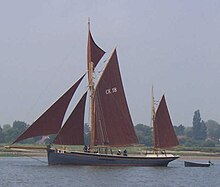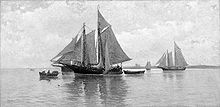
Back Smakke Danish Schmack German Sumaca Spanish Smak Frisian Semalo Italian スマック Japanese Smak Dutch Smakke NB Sumaca Portuguese Шмак Russian
This article needs additional citations for verification. (April 2019) |


A smack was a traditional fishing boat used off the coast of Britain and the Atlantic coast of America for most of the 19th century and, in small numbers, up to the Second World War. Many larger smacks were originally cutter-rigged sailing boats until about 1865, when smacks had become so large that cutter main booms were unhandy. The smaller smacks retained the gaff cutter rig. The larger smacks were lengthened and re-rigged and new ketch-rigged smacks were built, but boats varied from port to port. Some boats had a topsail on the mizzen mast, while others had a bowsprit carrying a jib.
Large numbers of smacks operated in fleets from ports in the UK such as Brixham, Grimsby and Lowestoft as well as at locations along the Thames Estuary. In England the sails were white cotton until a proofing coat was applied, usually after the sail was a few years old. This gave the sails its distinctive red ochre colour, which made them a picturesque sight in large numbers.[1] Smacks were often rebuilt into steam boats in the 1950s.
Smacks were developed to transport live lobsters during the late 1700s. They were designed to allow seawater to circulate in a tank with holes in it. [2]
- ^ March, E. J. (1970). Sailing Trawlers: The Story of Deep-Sea Fishing With Long Line and Trawl. David & Charles. ISBN 978-0-87742-004-0
- ^ "A Taste of Lobster History". HISTORY. 2018-08-23. Retrieved 2023-06-05.